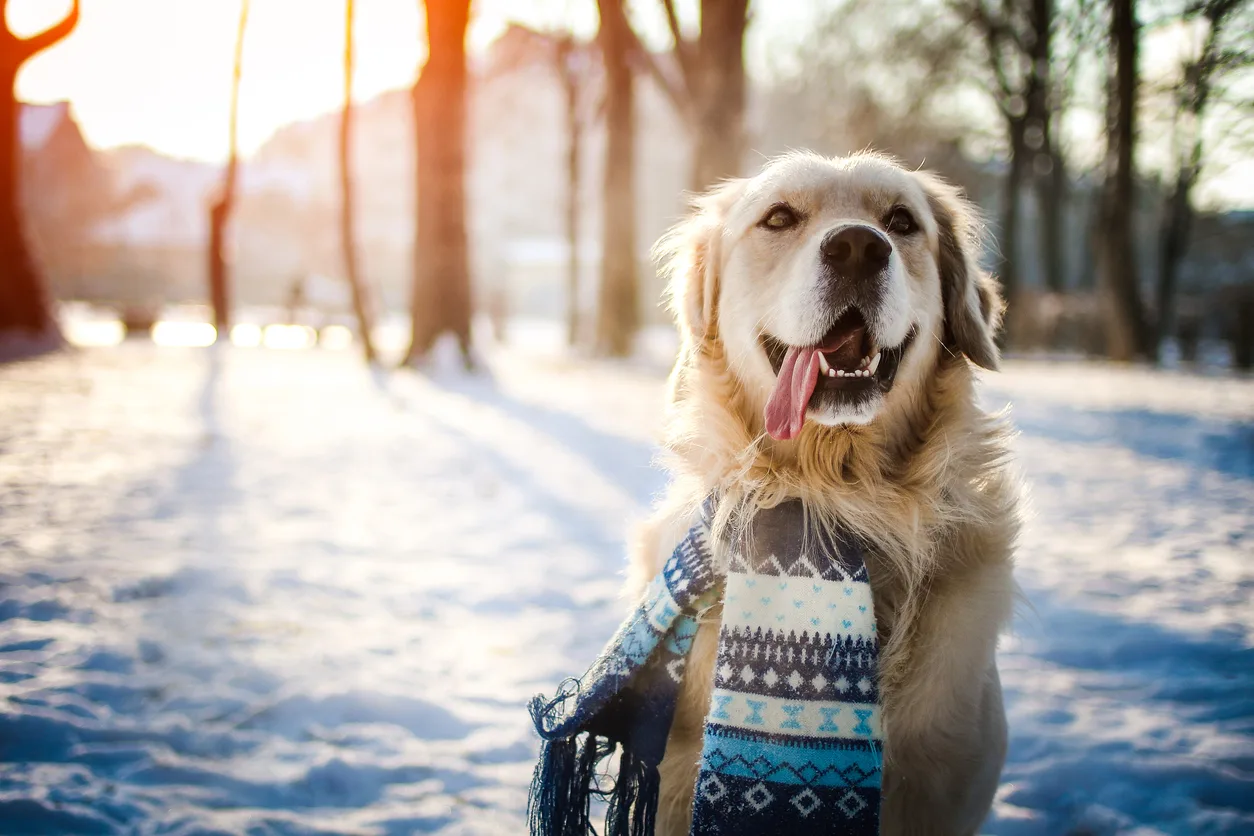Oh, the weather outside is frightful…but thankfully, there are ways to make your time outdoors with your pup delightful! Even if you live in the coldest parts of the United States, it is still possible to enjoy at least some time outdoors with your dog – and not just for a quick bathroom break.
Depending on the breed, you can probably enjoy everyday winter activities like snowman building, snowball throwing, and even sledding together just as you do in the spring, summer and fall. Regardless of whether you share your life with a Lhasa Apso or a Labrador, protecting your fur-baby from winter dangers is important.
Keeping Your Furry Friends Safe in Cold Weather Conditions
Wild winter weather wreaks havoc on the health of our furry friends if they are not properly cared for when outdoor temperatures plunge. Don’t make the mistake of believing that because your canine companion comes with a built-in fur coat that it doesn’t feel the bite of subfreezing temperatures, so bring your pup inside when during frigid conditions exist outdoors. Other cold weather considerations also exist.
The weather is beginning to cool off, and it is time to start thinking about winter safety for your dog. While many breeds are relatively resilient to colder weather, it is important to be proactive about their safety to prevent any unwanted injuries. Take a look at these few tips for keeping your dog safe and comfortable throughout the winter months.
Protect Those Paws
Regardless of whether you share your life with a Wolfdog or a Shar-Pei, protecting their paws from the cold is an important step to take. This is especially true if you live in the city or in a town where salt buildup can cause paw irritation on walks.
There’s a few different ways to protect tender tootsies, each of which may or may not be suitable for your dog. Booties are by far the best, but not all dogs care for them, and some just find the feeling too strange to walk at an even gait when wearing them.
If you try booties and they don’t work for your dog (hint: try these tips before you give up), use a good beeswax balm or even just petroleum jelly to coat the bottom of the paw liberally. This provides a protective layer between the paw and the road, reducing irritation and softening the impact of sharp little pieces of ice.
Your Dog’s Breed Matters
Before you can decide how to protect your dog in cold weather, you need to determine just how hardy he is to the cold in the first place. Make no mistake – all dogs require at least some protection during the cold; some breeds, like the Alaskan Malamute, may be able to better withstand low temperatures than others.
Generally speaking, short-haired breeds and those lacking a double coat will have more trouble weathering the cold than long-haired, double-coated breeds. Smaller dogs also seem to struggle with the cold more than large breeds. A Chihuahua will naturally find 0 °F weather unpleasant, while a Newfoundland or Bernese Mountain Dog may find the same temperatures refreshing.
It is at about 32°F that dog owners should start thinking twice about leaving their dog outside for long periods of time. There are definitely some dogs that thrive in these conditions, but many family pets will have a difficult time adapting to lower temperatures for a long period of time. At 32°F, it will also be difficult to keep your dog’s water supply from freezing over.
Stay Warm with Sweaters
Most of us can hear our parent’s winter advice ringing in our memories if we think back to a time past “Put on a sweater or you’ll catch your death of cold,” was a common reminder in most households, and remains so even today. While the idea that you’ll catch a cold from, well, being cold yourself, is overstated at best, it is important to bundle up before you venture outdoors – both for you and for your pup, depending on its breed.
Not all dogs need sweaters; in fact, larger breeds like the St. Bernard and Newfoundland dog may actually feel colder with a sweater on. The closeness of a sweater keeps their coat from insulating them from the cold properly, so leave the sweaters at home for large, double-coated breeds.
Short-haired breeds and smaller dogs, however, can benefit immensely from doggie sweaters and jackets when temperatures plummet. Clothing gives them an extra layer of insulation, keeping warmth close to the body while out on walks.
Not just any sweater will do; too-big, too-small, or too-thin jackets won’t provide the right level of warmth. Take measurements around your dog’s neck, around the widest part of his stomach, and around the smallest part of his stomach directly in front of his hips. Then, measure his spine from neck to his hips. Use these measurements to find the right jacket.
Material-wise, avoid anything knitted with large holes; tighter cable knits made from washable wool should be just fine. Acrylic and cotton also work well, as does polar fleece. Avoid stiff fabrics that don’t allow your dog to move freely, as well as difficult-to-undo zippers and buttons.
Style-wise, the choice is up to you; your pup can rock an ugly Christmas sweater or a lovely pea coat…whichever you prefer!
Remove Salt and Ice After Walks
Every owner should take some time to wipe off their dog’s paws, legs, and belly after they have been outside. In addition to keeping mud out of your home, this will also remove any salt, antifreeze, or other chemicals that could hurt them when they begin licking their fur and paws. If at all possible, your pets could be kept far from any streets or pathways where these chemicals are used.
Regardless of whether you use paw protectors or booties while out on walks, you should still inspect your dog’s paws, ankles, and lower body after walks. Salt and ice tends to chunk up in fur and may wedge itself between toes; you’ll see this most obviously if your dog starts limping mid-walk or once home. Check over the feet, legs, and lower belly as high up as the neck and hips and remove anything you find gently.
Can’t get that salt or ice out? Press a warm, wet cloth against the chunks once you’re home. Both salt and ice should loosen enough to remove it with ease. Don’t do baths unless absolutely necessary – they can cause your dog to catch a chill, making him susceptible to illness.
Consider a Longer Trim
Most people will trim their dog’s fur at least once or twice during the winter, but you might want to consider a longer cut when it is cold outside. Their undercoat is their primary source of insulation, but trimming their outer fur too short will expose their undercoat to the elements. As an alternative to a shorter trim, you might want to consider brushing them more often.
Clip Their Nails Weekly
If your dog is typically an outdoor dog, then you will need to take some extra time and trim their nails at least once a week. When dogs are outside, many of the surfaces that they run and play on will naturally trim their nails. Dogs that are kept indoors, however, might injure themselves when their longer nails get stuck on the carpet.
Only Allow Play in Fenced Perimeters
Many dogs find running and frolicking in fresh snowfall exhilarating and irresistible. However, you should only allow your dog to play in the snow in areas featuring fenced perimeters. The sense of smell becomes impaired when temperatures dip below freezing, and you pet may not be able to find its way back to you or to your home if it runs very far. More dogs are lost during the winter than at any other time of the year.
Keep Your Dog Hydrated
It is also important to keep your dog properly hydrated during winter cold snaps. Dry air is extremely dehydrating, and if your pet depends on an outdoor water dish, you should check it often to ensure the water hasn’t frozen over. Also, be on the lookout for itchy, dry patches of skin and apply appropriate products at the first sign of them.
Extra Food After Playtime Is Okay
There’s one thing most parents know to be true: if kids spend a great deal of time outside gallivanting through the snow, they’re bound to come inside afterward with a voracious appetite.
Snack time after skiing, sledding, or even just trouncing through deep snow is a must, and it isn’t just a preference, either; science shows that both you and your dog naturally burn off more calories when temperatures are low.
Some research shows that even just being outside in the cold is, in fact, a form of exercise all on its own. As your dog’s body cools down, it has to work harder to maintain it’s temperature, increasing energy expenditures that naturally demand more calories.
So what does all of this mean? Essentially, the more time you spend outdoors playing, the more reasonable it is to allow your dog to have a snack (or even a full bowl of food) once he comes indoors.
Although overfeeding can be a problem, it isn’t really considered overfeeding if you’re replacing lost calories and energy, so feel free to indulge the both of you when you come inside.
You can step this up a notch by offering a high-quality wet or moist kibble that’s been warmed up just a bit; he’ll enjoy it, and it will help him get warm again, too.
Whether you live in Arizona, where it stays fairly warm, or the mountains of Alaska, winter doesn’t need to spell the end of outdoor enjoyment for your family. Parents, kids, and yes, pets, too, can all find ways to make outdoor active living easy. With a little attention and dedication to protection from the cold and these fantastic tips, you’ll start to look forward to blissful days spent outdoors frolicking as the snow falls.

